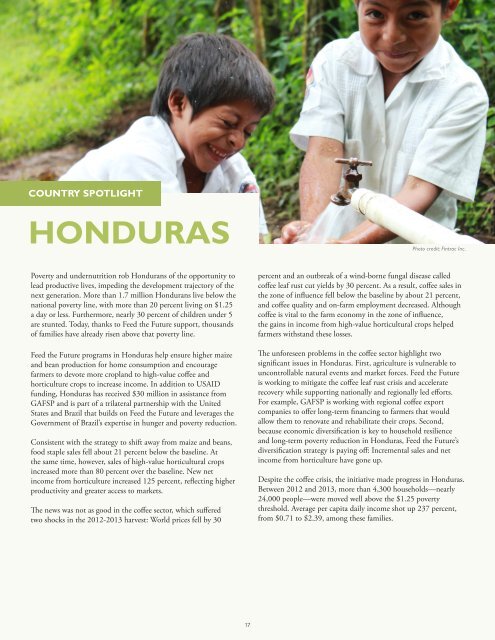ftf_progressreport_2014
ftf_progressreport_2014
ftf_progressreport_2014
You also want an ePaper? Increase the reach of your titles
YUMPU automatically turns print PDFs into web optimized ePapers that Google loves.
COUNTRY SPOTLIGHT<br />
HONDURAS<br />
Photo credit: Fintrac Inc.<br />
Poverty and undernutrition rob Hondurans of the opportunity to<br />
lead productive lives, impeding the development trajectory of the<br />
next generation. More than 1.7 million Hondurans live below the<br />
national poverty line, with more than 20 percent living on $1.25<br />
a day or less. Furthermore, nearly 30 percent of children under 5<br />
are stunted. Today, thanks to Feed the Future support, thousands<br />
of families have already risen above that poverty line.<br />
Feed the Future programs in Honduras help ensure higher maize<br />
and bean production for home consumption and encourage<br />
farmers to devote more cropland to high-value coffee and<br />
horticulture crops to increase income. In addition to USAID<br />
funding, Honduras has received $30 million in assistance from<br />
GAFSP and is part of a trilateral partnership with the United<br />
States and Brazil that builds on Feed the Future and leverages the<br />
Government of Brazil’s expertise in hunger and poverty reduction.<br />
Consistent with the strategy to shift away from maize and beans,<br />
food staple sales fell about 21 percent below the baseline. At<br />
the same time, however, sales of high-value horticultural crops<br />
increased more than 80 percent over the baseline. New net<br />
income from horticulture increased 125 percent, reflecting higher<br />
productivity and greater access to markets.<br />
The news was not as good in the coffee sector, which suffered<br />
two shocks in the 2012-2013 harvest: World prices fell by 30<br />
percent and an outbreak of a wind-borne fungal disease called<br />
coffee leaf rust cut yields by 30 percent. As a result, coffee sales in<br />
the zone of influence fell below the baseline by about 21 percent,<br />
and coffee quality and on-farm employment decreased. Although<br />
coffee is vital to the farm economy in the zone of influence,<br />
the gains in income from high-value horticultural crops helped<br />
farmers withstand these losses.<br />
The unforeseen problems in the coffee sector highlight two<br />
significant issues in Honduras. First, agriculture is vulnerable to<br />
uncontrollable natural events and market forces. Feed the Future<br />
is working to mitigate the coffee leaf rust crisis and accelerate<br />
recovery while supporting nationally and regionally led efforts.<br />
For example, GAFSP is working with regional coffee export<br />
companies to offer long-term financing to farmers that would<br />
allow them to renovate and rehabilitate their crops. Second,<br />
because economic diversification is key to household resilience<br />
and long-term poverty reduction in Honduras, Feed the Future’s<br />
diversification strategy is paying off: Incremental sales and net<br />
income from horticulture have gone up.<br />
Despite the coffee crisis, the initiative made progress in Honduras.<br />
Between 2012 and 2013, more than 4,300 households—nearly<br />
24,000 people—were moved well above the $1.25 poverty<br />
threshold. Average per capita daily income shot up 237 percent,<br />
from $0.71 to $2.39, among these families.<br />
17


